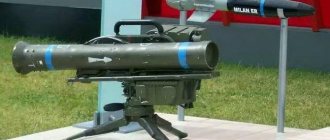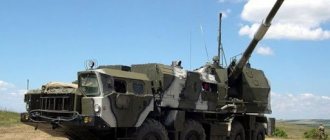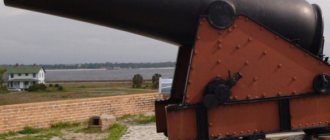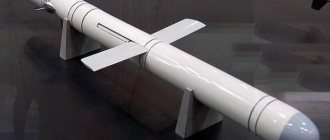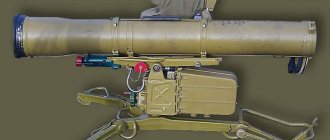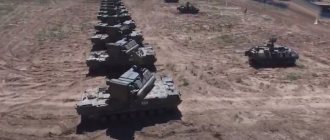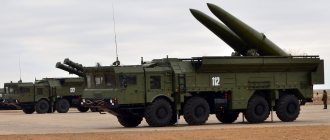Story
In 1990, the Almaz Central Design Bureau began developing the S-400 Triumph air defense system, which was used to replace different versions of the S-300 air defense system in the air defense forces. The new complex should use all versions of the missiles used in the S-300 and the 9M96 and 9M96 M missiles, specially developed for the new IKB Fakel missile system. The new missiles have the following features:
- super maneuverability mode;
- warhead with a controlled kill field;
- active radar homing during the final flight phase.
- The new Vityaz ground-based air defense system was created on the basis of the 9M96, and on the basis of the latter - the Poliment/Redut ship-based anti-aircraft missile system with the same types of missiles.
For the first time, information about the new air defense system appeared after the laying of the Novik patrol ship of Project 12441 in 1997. In front of the navigation bridge in the bow of the superstructure, it was planned to install four vertical launch modules with eight missiles each. But the adoption of the S-400 complex into service was delayed until 2007, as a result, Novik was left without an air defense system and was never completed (it was planned to be rebuilt into a training ship until 2015).
The Redut complex was also planned to be installed on the new Project 20380 corvettes, but as a result of the missile’s unavailability, the lead ship began to be used with the Kortik missile and artillery complex. “The Redoubt was installed on subsequent ships of the family (projects 20380, 20385). The same complex with a large number of UPV modules was used on the new Project 22350 frigates.
On February 8, 2022, Vladimir Korolev spoke about the completion of state tests of the Poliment/Redut air defense system. It was expected that it would enter service in the first half of 2022.
An excerpt characterizing the Redoubt (BRK)
“On the contrary, Your Majesty,” said Balashev, who barely had time to remember what was said to him, and had difficulty following this fireworks of words, “the troops are burning with desire...” “I know everything,” Napoleon interrupted him, “I know everything, and I know the number of your battalions is as true as mine. You don’t have two hundred thousand troops, but I have three times that much. “I give you my word of honor,” said Napoleon, forgetting that his word of honor could not have any meaning, “I give you ma parole d’honneur que j’ai cinq cent trente mille hommes de ce cote de la Vistule.” [on my word of honor that I have five hundred and thirty thousand people on this side of the Vistula.] The Turks are no help to you: they are no good and have proven this by making peace with you. The Swedes are destined to be ruled by crazy kings. Their king was mad; they changed him and took another - Bernadotte, who immediately went crazy, because a crazy person only being a Swede can enter into alliances with Russia. - Napoleon grinned viciously and again brought the snuffbox to his nose. To each of Napoleon’s phrases, Balashev wanted and had something to object to; He constantly made the movement of a man who wanted to say something, but Napoleon interrupted him. For example, about the madness of the Swedes, Balashev wanted to say that Sweden is an island when Russia is for it; but Napoleon shouted angrily to drown out his voice. Napoleon was in that state of irritation in which you need to talk, talk and talk, only in order to prove to yourself that you are right. It became difficult for Balashev: he, as an ambassador, was afraid of losing his dignity and felt the need to object; but, as a person, he shrank morally before forgetting the causeless anger in which Napoleon, obviously, was. He knew that all the words now spoken by Napoleon did not matter, that he himself, when he came to his senses, would be ashamed of them. Balashev stood with his eyes downcast, looking at Napoleon’s moving thick legs, and tried to avoid his gaze. - What do these allies of yours mean to me? - said Napoleon. – My allies are the Poles: there are eighty thousand of them, they fight like lions. And there will be two hundred thousand of them. And, probably even more indignant that, having said this, he told an obvious lie and that Balashev stood silently in front of him in the same pose submissive to his fate, he turned sharply back, walked up to Balashev’s very face and, making energetic and quick gestures with his white hands, he almost shouted: “Know that if you shake Prussia against me, know that I will erase it from the map of Europe,” he said with a pale face distorted with anger, striking the other with an energetic gesture of one small hand. - Yes, I will throw you beyond the Dvina, beyond the Dnieper and will restore against you that barrier that Europe was criminal and blind in allowing to be destroyed. Yes, that’s what will happen to you, that’s what you won by moving away from me,” he said and silently walked around the room several times, trembling his thick shoulders. He put a snuff box in his vest pocket, took it out again, put it to his nose several times and stopped in front of Balashev. He paused, looked mockingly straight into Balashev’s eyes and said in a quiet voice: “Et cependant quel beau regne aurait pu avoir votre maitre!” Balashev, feeling the need to object, said that from the Russian side things were not presented in such a gloomy way. Napoleon was silent, continuing to look at him mockingly and, obviously, not listening to him. Balashev said that in Russia they expect all the best from the war. Napoleon condescendingly nodded his head, as if saying: “I know, it’s your duty to say so, but you yourself don’t believe in it, you’re convinced by me.” At the end of Balashev’s speech, Napoleon took out his snuffbox again, sniffed from it and, as a signal, tapped his foot twice on the floor. The door opened; a respectfully bending chamberlain handed the emperor his hat and gloves, another handed him a handkerchief. Napoleon, not looking at them, turned to Balashev.
Design Features
The complex includes the Poliment radar with four phased arrays. The number of simultaneously fired enemy targets is 16 (it turns out four for each phased array).
The missiles are located in vertical launch systems, which consist of modules of four or eight cells each. The cell contains 1 transport and launch container with a medium or long-range missile (9M96E, 9M96E2) or four short-range missiles (9M100). It is worth noting that a “cold” start is used when starting. The missile is ejected from a vertically located transport and launch container with a charge of compressed air to a height of 30 meters, turning with the help of a gas-dynamic system towards the target. Thanks to this, the minimum interception range is significantly reduced. The gas-dynamic system also provides the rocket with super-maneuverability mode and can increase the rocket’s overload by 20 g in 0.025 seconds.
In the mid-flight section of the trajectory for the 9M96E and 9M96E2 missiles, inertial command guidance is used, while in the final section, active radar homing is used. At the same time, the 9M100 short-range missile is equipped with an infrared homing head. Immediately after the missile is launched, the target is captured.
According to computer modeling and full-scale tests, 9M96E and 9M96E2 missiles with a high probability (70%) ensure an accurate hit on the warhead of a tactical missile, and in the other 30% case the deviation is no more than a few meters. The probability of hitting an airplane is 80%, while a helicopter is 90%.
Thanks to multi-point initiation, the 24 kg warhead has a controlled kill field.
Coastal missile system "Redut"
The P-5 submarine cruise missile, created in the second half of the fifties, became the basis for a whole family of missile weapons for various purposes. The result of its modernization was the appearance of the P-6 missile with a homing system intended for arming submarines. At the same time, the P-35 missile with a set of appropriate equipment was created for warships. Subsequently, the P-35 missile became the basis for new weapons with improved characteristics and several new systems. On its basis, the Redut and Utes coastal missile systems were developed. Even before the completion of work on the original project of the P-35 ship-borne cruise missile, it was decided to create on its basis a coastal anti-ship operational-tactical missile system for hitting surface targets at a distance of up to several hundred kilometers from the coast. The decree on the beginning of the creation of such a system was issued on August 16, 1960. By this time, the P-35 missile had already entered preliminary tests in incomplete configuration. In addition, the development of a number of auxiliary systems that were to ensure the combat operation of the ship complex was almost completed. Thus, there was a real opportunity to simplify and speed up work on the coastal complex to a certain extent.
The development of the new project was entrusted to OKB-52 under the leadership of V.N. Chelomey, who created all the previous products of the family based on the P-5. In addition, several other organizations were involved in the work, whose task was to develop and supply some components. The project of the coastal complex received the symbol “Redoubt”. The missile for him was designated as P-35B.
The SPU-35 launcher of the Redut complex is in position. Photo Rbase.new-factoria.ru
The main element of the Redut complex was to be the P-35B anti-ship missile, created on the basis of the original P-35. The new rocket was supposed to differ from the base product in the composition of its on-board equipment and some other minor changes. At the same time, the general design and operating principles of the rocket had to remain the same. The appearance of the product, related to the specific aerodynamics, did not change either.
The P-35D missile, with a total length of about 10 m and a wingspan of 2.6 m, was a further development of the ideas laid down in the P-5/6 projects, and was based on the design of the basic P-35. It had an elongated streamlined fuselage with a pointed head fairing and a smooth tail section to accommodate the main engine nozzle. Due to the use of a turbojet engine, the rocket received an air intake with a conical central body located under the bottom of the fuselage.
Like other products of the family, the P-35B was to be equipped with a swept folding wing. In order to reduce the dimensions of the rocket in the transport position, the wing was divided into a small center section and rotary consoles. In the transport position, the wing consoles were turned down and laid along the sides of the fuselage, due to which the maximum width of the product did not exceed 1.6 m. After leaving the launch container during launch, special automation had to lift the consoles and fix them in a horizontal position.
The rocket was controlled in flight using a set of rudders in the rear fuselage. There were all-moving stabilizers-elevators, and the rocket had to maneuver along the course using a rudder on the fin. The latter was located under the fuselage, next to it it was planned to mount a double starting solid fuel engine.
P-35 missile on a transport trolley. Photo Warships.ru
The weight parameters of the missile for the coastal complex remained at the level of the basic ship product. The dry weight of the rocket was 2.33 tons, the launch weight was 5.3 tons, including the 800-kilogram jettisonable starting engine. The design of the rocket allowed it to carry a warhead weighing up to 1000 kg. It was proposed to use a high-explosive or nuclear warhead to hit targets. The power of the latter, according to some sources, reached 350 kt.
The power plant of the P-35B missile was borrowed from the base product without changes. For launch and exit from the launch container, followed by acceleration and rise to a small height, a solid fuel accelerator was proposed, consisting of two blocks with a thrust of 18.3 tons, connected by a common frame. After running out of fuel, after 2 seconds of operation, the starting engine had to fire back. The further flight was proposed to be carried out using a KR7-300 turbojet engine with a thrust of 2180 kg. This product replaced the KRD-26 engine, which was used on previous missiles of the family.
According to available data, the P-35B missile guidance system was a redesigned version of the basic P-35 equipment. It was decided to abandon the ability to control the rocket during the flight to the target area, completely entrusting this work to the inertial system. At the same time, the active radar homing head was retained with the ability to work as a sighting device. She was supposed to be responsible for finding the target and further targeting it. It is noteworthy that identifying the target and launching its attack remained the task of the complex operator.
Diagram of the combat operation of the Redut complexes and P-35 ship-based missiles. Figure Rbase.new-factoria.ru
To transport and launch P-35B missiles, a special launcher SPU-35 was developed, built on the basis of a serial wheeled chassis. The four-axle special chassis ZIL-135K was taken as the basis for this vehicle. Subsequently, the production of this vehicle was transferred to the Bryansk Automobile Plant, which is why it received the new designation BAZ-135MB. The chassis was equipped with a 360 hp engine. and could transport cargo weighing about 10 tons. It was possible to move on the highway at speeds of up to 40 km/h with a power reserve of up to 500 km. The launcher, like other missile systems, being built on a cross-country chassis, had the ability to travel on roads and over rough terrain.
It was proposed to mount missile container installation systems on the rear cargo platform of the base chassis. The launch container, more than 10 m long with an internal diameter of about 1.65 m, was hinged at the rear of the chassis and could swing in a vertical plane using hydraulic drives. Inside the container there were rails for attaching and launching the rocket, as well as a set of connectors for interaction between the electronic systems of the installation and weapons. The container was equipped with two movable lids. Before launch, they had to be lifted up and placed on special platforms on the roof of the container.
To interact with the self-propelled launcher, a transport-loading vehicle was developed with the ability to transport one P-35B missile. If necessary, the TZM crew had to load a new missile into the container of the SPU-35 launcher, after which it could attack the target again.
The Redoubt complex is on the march. Photo Arms-expo.ru
Another element of the Redut anti-ship operational-tactical complex was to be a control vehicle. A radar station for monitoring the water area and searching for targets, as well as a 4P45 “Skala” control system, were installed on the vehicle chassis. Such a command post was supposed to track targets and control the missile launch. In addition, the task of the “Skala” operator was to identify and identify targets, as well as distribute them between missiles and issue data to launchers.
The following organizational structure of connections was proposed. The battery of the Redut complex included eight launchers and transport-loading vehicles, as well as a control center and various support equipment. Batteries should be united into battalions, battalions into brigades. At the brigade level, it was proposed to use additional radar equipment to monitor the situation and issue initial target designation to battery systems.
According to the principles of operation, the Redut complex with the P-35B missile was to a certain extent similar to ship-based or underwater systems with similar missiles, but had some differences. Having arrived at the indicated position, the crew of the complex had to deploy. It took about an hour and a half to prepare all the complex’s assets for combat work. After this, the complex could conduct combat work and attack enemy ships.
A control vehicle with the Skala system and its own radar was supposed to monitor the situation in the covered area. Its task was to search for enemy surface ships that pose a danger. It was also possible to receive target designation from other detection means, including airplanes or helicopters. When a target was detected, it was tracked and its nationality and danger were determined. After the decision to attack was made, the battery control machine had to transmit data to the launchers and give the command to fire.
Rocket launch. Photo Warships.ru
In preparation for launching a rocket, the launcher had to occupy a specified position and raise the container to a starting elevation angle of 20°. After lifting, the covers were opened, ensuring unhindered exit of the rocket and release of gases from the starting engine. On command from the control vehicle, the rocket had to turn on the starting engine and leave the container, receiving an initial impulse, picking up speed and rising to the required altitude.
In accordance with the introduced flight mission, the P-35B missile was supposed to independently reach the target area, using the existing inertial navigation system and radio altimeter. Depending on the calculated route, the missile could fly at an altitude of 400, 4000 or 7000 m. After reaching the specified target area, the missile had to turn on the active radar seeker and “inspect” the water area. Data from the radar system should have been transmitted to the control vehicle, whose operator would have the opportunity to study the situation and select a target. After this, the seeker captured the specified target and independently aimed the missile at it. The last leg of the flight took place at an altitude of 100 m, which reduced the likelihood of detection and interception. The missile's capabilities made it possible to destroy targets at ranges of up to 270 km. The high-explosive warhead ensured the destruction of single targets, and the special one could be used to destroy group targets.
The project of the Redut coastal missile system with the P-35B missile was developed by mid-1963. Testing of the new system began in the fall. The first two test launches were considered unsuccessful. It was found that the new sustainer turbojet engines cannot yet fully cope with their work. Malfunctions in the operation of radio-electronic systems were also identified. Because of this, the tests had to be interrupted to fine-tune the complex. Problems during the first tests resulted in serious delays in work. The Redut complex was put into service only in August 1966.
For various reasons, the supply of new systems to the troops and their further development have been noticeably delayed. The first formation armed with Redoubts began full service only in 1972. According to available data, the coastal missile forces of the Baltic Fleet were the first to receive these complexes. By the beginning of the winter of 1972, the 10th separate coastal missile regiment, armed with systems of previous types, was transformed into the 1216th separate coastal missile division and equipped with Redut complexes. In the fall of 1974, the division was reorganized again, now it became the 844th separate coastal missile regiment (OBRP).
Shooting from a different angle. Photo Armedman.ru
Subsequently, the re-equipment of the missile units of the coastal forces of other fleets began, accompanied by the mass production of the Redut complexes. According to available data, by the end of the eighties, the coastal missile forces and artillery of the USSR Navy had 19 battalions of the Redut complex. The Baltic Fleet received the largest number of such systems (6 battalions). The Pacific and Black Sea fleets deployed five battalions each, the Northern - three. It should be noted that the Northern and Black Sea fleets included Utes missile systems, which can be considered a stationary analogue of Reduta. Each Utes complex had eight launchers for P-35B missiles.
During their service, all units armed with P-35B missiles repeatedly participated in combat training activities and launched missiles at mock targets. Of particular interest are the tasks performed by the missile regiment from the coastal forces of the Black Sea Fleet. Several times he received orders to move into the territory of friendly Bulgaria and take up firing positions there. Such a relocation of launchers made it possible to fire at a large area, which included sections of the Black, Aegean and Marmara Seas, as well as the Dardanelles.
Initially, the Redut coastal missile systems were intended only for the armed forces of the Soviet Union and export deliveries were not envisaged. However, after the appearance of newer systems with improved characteristics, the Redoubts began to be exported. According to reports, a number of such systems were sold to Vietnam, Syria and Yugoslavia.
In 1974, the modernization of the P-35 missile began, affecting all complexes using it. In order to improve the characteristics of the weapon, the development of the 3M44 “Progress” project began. Such a missile was supposed to differ from the basic P-35 with a new launch engine and a seriously redesigned control system. The latter was distinguished by increased noise immunity and selectivity of action. To further increase the rocket's efficiency, the final low-altitude flight segment was increased.
Operation of rocket boosters. Photo Pressa-tof.livejournal.com
The 3M44 missile was put into service in 1982. By this time, mass production had been launched and deliveries of missiles to the troops began. This weapon was intended for use as part of the Redut complex, and could also be used by existing P-35 carrier ships. The appearance of the new missile had a positive impact on the combat effectiveness of all missile systems using it, including the Redut coastal system.
Despite the emergence of a number of new coastal missile systems, the Redut system still remains in service and solves the problem of protecting the coast from enemy ships, complementing newer systems. The operation of such complexes will continue for some time, after which they will probably be removed from service due to moral and physical obsolescence.
The Redut coastal missile system was put into service half a century ago and all this time has protected the country’s maritime borders from attack by a potential enemy. Like any other new systems, “Redut” at the time of its appearance was distinguished by high performance and made it possible to solve all assigned tasks with high efficiency, but over time it became outdated and gave way to newer and more advanced systems.
The head of the launch crew checks the container after launch. Photo Pressa-tof.livejournal.com
During its appearance and over the next few decades, the Redut complex with the P-35B missile, and then with the 3M44, featured a number of important advantages. It had the ability to attack targets at ranges of up to 300 km and could deliver a warhead to a target that would disable an enemy ship (high explosive) or a naval formation (special). A combined guidance system with target determination by the operator made it possible to distribute targets among several missiles, including pointing several missiles at one enemy ship. The use of external target designation made it possible to increase the size of the controlled water area.
However, there were also disadvantages. Over time, the P-35B missile no longer met some requirements. It differed from newer models in that it was too large in size, which is why the self-propelled launcher could only carry one missile. Also, due to the large size of the launch container, the self-propelled launcher does not have its own means of target detection and fire control, which is why it requires additional vehicles with similar equipment. In addition, Redoubt takes too long to deploy.
Despite not fully meeting the requirements of the time, the Redut coastal missile system still remains in service, although it is giving way to newer systems that are distinguished by improved characteristics and greater efficiency. Time will tell whether the new complexes will be able to compete with Redut in terms of service life.
Based on materials: https://rbase.new-factoria.ru/ https://warships.ru/ https://bastion-karpenko.narod.ru/ Shirokorad A.B. Weapons of the domestic fleet. 1945-2000. – Mn.: “Harvest”, 2001
Photo report from the exercises of the coastal forces of the Pacific Fleet with firing of the Redut complex: https://pressa-tof.livejournal.com/28744.html
Performance characteristics (for export modifications of missiles)
For clarity, the characteristics of the 48N6E missile of the Fort air defense system (S-300) are given.
| Characteristic | project 1997 | 48N6E | 9M96E2 | 9M96E2-1 | 9M96E | 9M100 | 9М100E |
| Number of missiles in a UVP cell | 1 | 1 | 1 | 1 | 4 | ||
| Number of steps | 1 | 1 | 1 | 1 | 1 | 1 | |
| Engine | Solid propellant rocket engine | Solid propellant rocket engine | Solid propellant rocket engine | Solid propellant rocket engine | Solid propellant rocket engine | Solid propellant rocket engine | Solid propellant rocket engine |
| Maximum firing range, km | 70 | 120 | 120 | 120 | 40-50 | 10-15 | 15 |
| Minimum firing range, km | 5 | 1 | 2,5 | 1 | 0,5 | ||
| Maximum target height, km | 27 | 30 | 30 | 20 | 8 | ||
| Minimum target height, m | 10 | 5 | 5 | 5 | 5 | ||
| Rocket mass, kg | 1800 | 420 | 598 | 330 | 140 | ||
| Weight of warhead, kg | 145 | 24 | 24 | 24 | 14,5 | ||
| Rocket length, m | 7,50 | 5.35 | 5,6 | 4,75 | 2,50 | 3,17 | |
| Case diameter, mm | 519 | 240 | 240 | 240 | 125 | 200 | |
| Wingspan, mm | 1134 | 480 | 536 | ||||
| Rocket speed, m/s | 3000 | 2100 | 900 | ||||
| Maximum target speed, m/s | 2800 | 4800 | 4800 | 1000 | 1000 |
Literature
- Evgeny Kochnev.
Secret cars of the Soviet Army. - M.: Yauza, 2011. - 760 p. - (War of Motors). — ISBN 978-5-699-50821-1.
| Tactical complexes with | "FKR-1" • "FKR-2" |
| RCSN with | La-350 "Storm" • |
| Italic complexes that were not included in the series were highlighted. | |
Carriers
- Project 20380 corvettes
On these corvettes, starting from the 2nd serial ship, in front of the navigation bridge in the bow of the superstructure, instead of the Kortik-M air defense missile system, three Redut air defense missile system modules are installed, with four cells in each (twelve cells in total). Ammunition - 48 9M100 missiles or a different combination of 9M96E and 9M100 missiles within the full capacity of the UVP and 12 9M96E missiles.
The Izvestia newspaper reported that the standard Poliment target illumination radar is not used on Project 20380 corvettes and its further modifications due to lack of space. As a result, in the mid-flight section of the trajectory, long- and medium-range missiles proceed without trajectory correction on the inertial autopilot, and when intercepting a maneuvering enemy target, the homing head of the missile that has reached the interception point often does not detect the target. All 3 tests of the Redut anti-aircraft missile system with the 9M96M missile carried out in 2012 (2 from the Soobrazitelny corvette and 1 from a ground-based installation) ended in failure. The 9M100 short-range missile is absolutely functional; at the beginning of its trajectory it locks onto the target with a special infrared homing head.
At the beginning of the summer of 2014, the Soobrazitelny corvette of the Baltic Fleet effectively repelled an attack by a target cruise missile launched from the R-257 missile boat using the Redut air defense system. As a result, the target was successfully destroyed. Apparently, this was the first successful use of the Redoubt complex from a warship.
- Project 20385 Corvettes
On these corvettes, the UVP of the Redut anti-aircraft missile system was moved from the bow to the stern (in their place, the UVP of the UKSK missile system was installed). Four modules of four cells each are installed side by side between the helipad and the hangar (16 cells in total). Ammunition - 64 9M100 missiles or 16 9M96E missiles, or various combinations of 9M100 and 9M96E missiles within the full UVP capacity.
3. Project 22350 frigates
On these frigates, in front of the navigation bridge in the bow of the superstructure, four UVP modules of the Redut air defense system are installed, with eight cells in each (that’s 32 cells). Combat reserve - 128 9M100 missiles or 32 9M64E missiles or various combinations of 9M100 and 9M96E missiles within the full UVP capacity.
Exploitation
According to reports dated 06/02/2014 and 09/19/2014, when going to sea, the crew of the project 20380 corvette “Soobrazitelny” of the Baltic Fleet carried out tasks to repel a missile strike from a potential enemy. Both times, a cruise missile was used as a target, which was launched from the R-257 missile boat. The target was fired from the Redut sea-based anti-aircraft missile system. The missile launched from the corvette hit the target both times. The shooting took place in a severe interference environment with the enemy using electronic warfare equipment.
According to a report dated June 11, 2014, at the sea training ground of the Baltic Fleet, the crew of the corvette Soobrazitelny conducted a tactical exercise for the first time, the purpose of which was to hit a surface target with an anti-aircraft missile. The shooting took place using the Redut sea-based anti-aircraft missile system at a simulating ship of a potential enemy. A missile launched from a corvette successfully hit a naval target at a given distance. The shooting was carried out in a difficult jamming environment with the enemy using electronic warfare equipment.
According to a report dated August 25, 2016, during a tactical exercise, the Soobrazitelny corvette, using the Redut air defense system, hit a target simulating an anti-ship missile. The Western Military District spoke about this. The target missile was fired from the Geyser small rocket ship. The report notes that the shooting was carried out in a difficult jamming environment with the use of enemy electronic warfare equipment.


